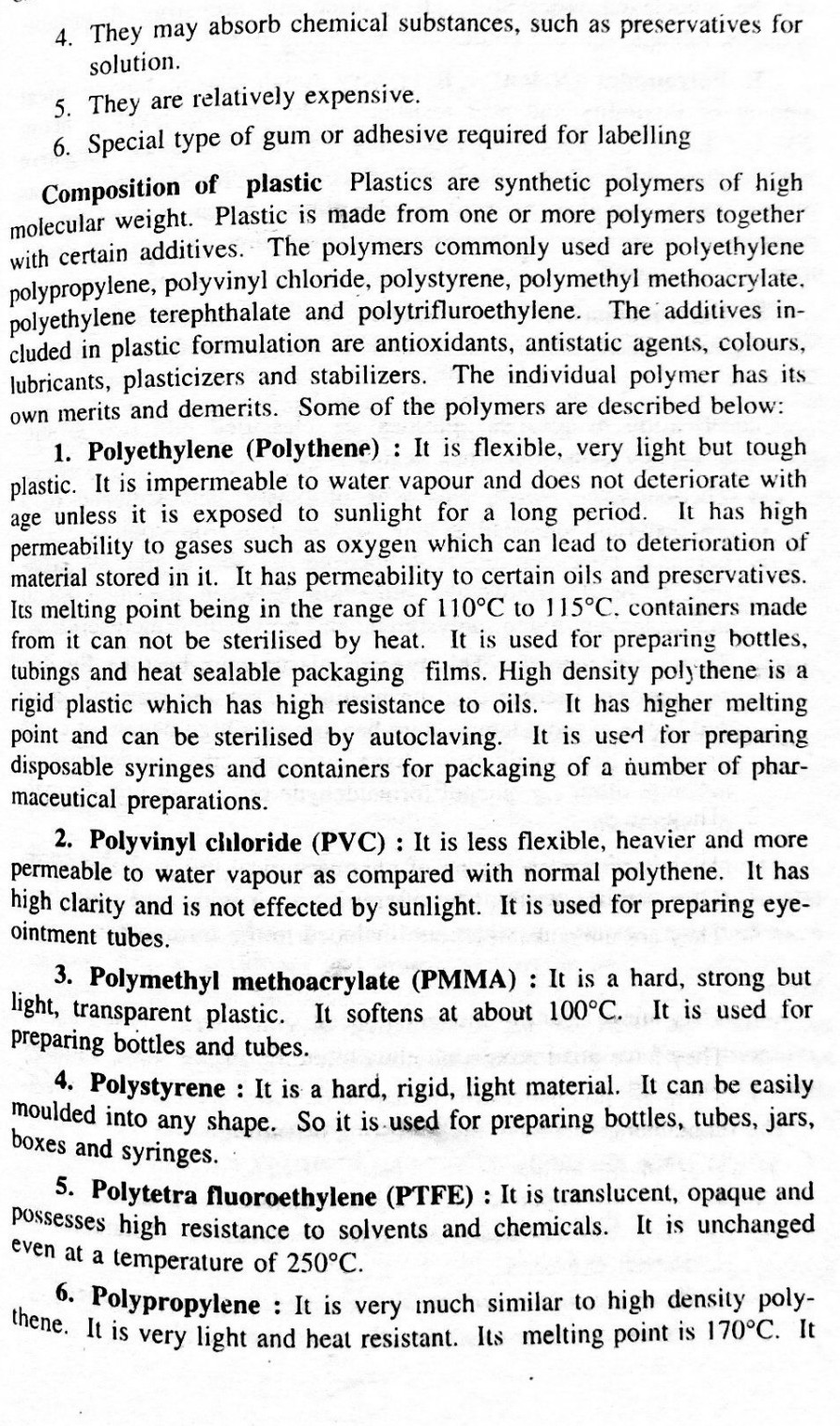Chapter - 4
Packaging of Pharmaceuticals
Contents
1. Definition
2. Qualities of Good Container
3. Types of Container
4. Materials Used in Making of Containers
5. Closures
6. Types of Closures
7. Materials Used in Making of Closures
8. Aerosol Packaging
9. Modern Unit Dose Packaging
After the manufacturing of drugs, it is essential that these should be stored properly. The stability of drug during its storage depends on so many factors and proper packaging is one of them. The pharmaceutical products are in direct contact with the containers and closures. So improper packing and poor quality of containers may lead to deteriora tion of the products.
Pharmaceutical container has been defined as a device that holds the drug and it may or may not be in direct contact with the pharmaceutical preparations. Closures are the devices by means of which containers can be opened and closed.
Qualities of a Good Container
1. It should be made of materials which can withstand wear and tear during normal handling.
2. The container must have a pharmaceutically-elegant appearance.
3. It should be so designed that a dose can be drawn from it conveniently.
4. The container must be neutral towards the material which is stored in it.
5. It should help in maintaining the stability of product against the environmental factors which cause its deterioration.
6. The material used for making of the container must be non toxic.
7. It should be able to withstand changes in pressure and tempera ture. This is required in case of sterilisation of parenteral products along with its container and closure.
8. The container must not interact physically or chemically with the substance which it holds, so as to change the strength, quality or purity of the substance.
9. The container must be such that it can be labelled easily.
10. The closure of the container must be easily removable and replaceable.
TYPES OF CONTAINERS
Containers are divided into following types on the basis of their utility:
1. Single dose containers: These containers are used to supply only one dose of medicament and hold generally parenteral products e.g. ampoules and vials.
2. Multi dose containers: These containers allow the withdrawal of dose at various intervals without changing the strength, quality or purity of remaining portion. These containers hold more than one dose and are used for injectables e.g. vials.
3. Light-resistant containers: These containers protect the medi cament from harmful effects of light. These containers are used to store those medicaments which are photo-sensitive.
4. Well-closed containers: A well-closed container protects the contents from loss during transportation, handling, storage or sale etc.
5. Air-tight containers: These are also called hermetic containers. These containers have air-tight sealing or closing. These containers protect the products from dust, moisture and air. Whereas air-tight sealed containers are used for injectables, air-tight closed containers are meant for the storage of other products.
6 Tightly-closed containers: These containers protect the con tents from contamination by liquids, solids or vapours, from loss or deterioration of the material from effervescence, deliquescence or evapo ration under normal condition of handling, storage and distribution. A tightly closed container must be capable of being tightly re-closed after use e.g. gas cylinder is a metallic tightly closed container designed to hold gas under pressure.
7. Temper-evident containers: These containers are fitted with a device or mechanism that reveals irreversibly whether the container has been opened.
8. Aerosol containers: These containers are used to hold aerosol products. These containers have adequate mechanical strength in order to bear the pressure of aerosol packing.
MATERIALS USED FOR MAKING OF CONTAINERS
The containers used for pharmaceutical products are usually made from the following basic materials:
1. Glass
2. Plastic
3. Metal
4. Paper and board

















Comments
Post a Comment